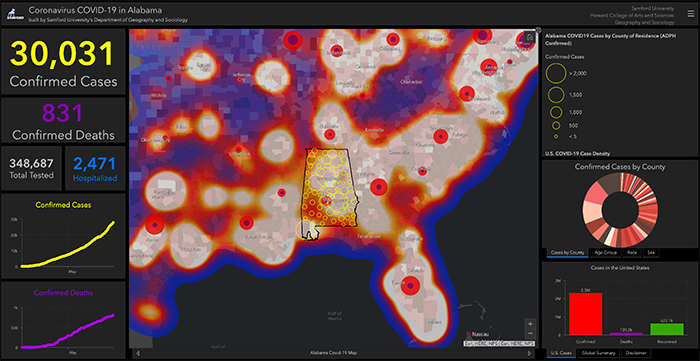
Samford’s Department of Geography and Sociology has long been engaged with Geographic Information Systems (GIS) technology, which allows sophisticated gathering, analysis, mapping and reporting of geographic data. In mid-March, as higher education was upended by COVID-19, professor Jonathan Fleming sought a way to apply the technology to help make sense of the pandemic.
The data Fleming wanted to see was scattered around the internet. In those early days of the pandemic shutdown in the south, the Alabama Department of Public Health (ADPH) didn’t have a data dashboard, and was posting updated counts in a table on its website. Even the most widely used COVID-19 data site, created by Johns Hopkins University, wasn’t reporting county level data in the U.S. “This provided an opportunity to create something specifically for folks in Alabama using the expertise we already had in our department–to practice what we preach and demonstrate the use of spatial data science in action for collection, analysis, visualization, and sharing of pertinent information with the public,” Fleming said.
The resulting Coronavirus COVID-19 in Alabama data dashboard project goes far beyond simple counts of infections and deaths. “I wanted to include other data to give folks more spatial and social context,” Fleming said. “Our dashboard included data from Centers for Disease Control’s social vulnerability index and population data broken down by age and race, which are still hot topics being discussed with regard to impacts from COVID-19.” He has continuously updated the site and added additional content as different model projections and methodologies are developed to show trends in the spread of COVID-19.
The overwhelming public response to Fleming’s project suggests that others were as hungry as he was for meaningful regional data. The site was viewed almost 135,000 times in a single day in March. The traffic has decreased as new dashboards have emerged, including from ADPH, and as data fatigue sets in, but Fleming said the site still averages 1,000-2,000 visits per day. The project has been viewed more than half a million times since its mid-March launch.
Fleming didn’t get much chance to incorporate the project into his teaching in the spring semester, but sees two important classroom applications going forward. “First, this is what we do, so this is a great way to teach students how to create these tools and to illustrate their importance in keeping the public informed,” he said. “Second, it is a centralized place to discuss the geography of Covid-19 and how it relates to other social and demographic factors across the landscape. Everyone these days has gotten a taste of data science and we want to help our students learn to apply critical thinking skills to get past what the numbers look like on the surface.”
This March 18 story was updated June 22

